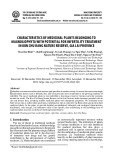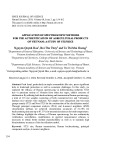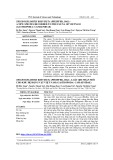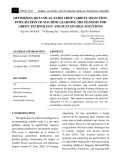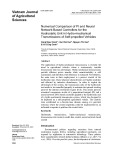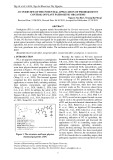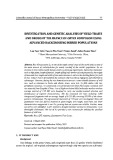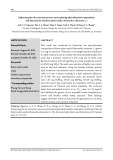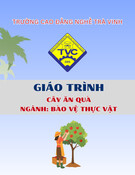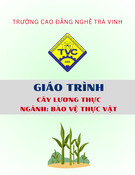
Int.J.Curr.Microbiol.App.Sci (2018) 7(7): 607-621
607
Original Research Article https://doi.org/10.20546/ijcmas.2018.707.074
Diversity of Epiphytic Lactic Acid Bacteria (LAB) on
Insect Oviposition Sites
R. Harshini1, P. Yasodha1*, K.G. Sabarinathan1, V. Ambethgar1 and P.M.M. David2
1Anbil Dharmalingam Agricultural College and Research Institute,
Trichy–620009, Tamil Nadu
2Agricultural College and Research Institute, Killikulam,
Vallanadu – 625 282, Tamil Nadu, India
*Corresponding author
A B S T R A C T
Introduction
With pesticides leading to environmental
pollution, alternative strategies need to be
explored in integrated pest management.
Lactic acid bacteria (LAB) such as
Carnobacterium, Enterococcus, Lactobacillus,
Lactococcus, Leuconostoc, Oenococcus,
Pediococcus, Streptococcus, Tetragenococcus,
Vagococcus and Weissella (Stiles and
Holzapfel, 1997; Makarova et al., 2006)
which produce a variety of antimicrobial
compounds and other substances, confer a
range of health benefits not only in higher
animals but also in insects, e.g. honeybee
(Vásquez et al., 2012; Mathialagan, 2014).
They are generally recognized as safe (GRAS)
food grade microorganisms exploited as
probiotics (Salminen, 1998) and in
biopreservation (Carr et al., 2002; Dalie et al.,
2010). They occur not only in food-related
habitats such as milk but also in soil, water,
manure, sewage, silage and plants (Harzallah
and Belhadj, 2013). The potential of epiphytic
LAB as biocontrol agents against
phytopathogenic bacteria and fungi has earlier
been documented (Trias et al., 2008). While
bacterial species such as Staphylococcus sp.
International Journal of Current Microbiology and Applied Sciences
ISSN: 2319-7706 Volume 7 Number 07 (2018)
Journal homepage: http://www.ijcmas.com
Alternative strategies are needed in pest management to protect crops from
pests. Occurrence of epiphytic lactic acid bacteria (LAB) on crop plants,
especially on sites that are selected by pests, may be associated with host
selection by insects. We carried out laboratory investigations as well as
screen house and field experiments to understand whether epiphytic LAB
occur at oviposition sites of agricultural and horticultural crops, probably
modulating pest abundance by attraction or repulsion. The diversity of such
epiphytic LAB associated with insect oviposition sites is discussed.
K e y w o r d s
Insect oviposition
sites, Crop plants,
Epiphytic lactic
acid bacteria (LAB)
Accepted:
06 June 2018
Available Online:
10 July 2018
Article Info

Int.J.Curr.Microbiol.App.Sci (2018) 7(7): 607-621
608
and Bacillus sp. associated with oviposition
resources serve to regulate subsequent insect
attraction and colonization (Zheng et al.,
2013), LAB may also help regulate pest
populations on plants. The objective of this
investigation was to understand the diversity
of epiphytic LAB that occur on sites selected
by lepidopteran insects for oviposition so that
they can be exploited to modulate pest
populations in IPM.
Materials and Methods
Laboratory, screenhouse and field experiments
were conducted at the Department of
Agricultural Entomology, Anbil
Dharmalingam Agricultural College and
Research Institute, Trichy, Tamil Nadu during
2015-16.
Laboratory studies
Crop samples (ca. 1” long, 1 cm wide) that
serve as probable oviposition sites were
collected between 6.00 and 8.00 am. The
impression method was adopted to isolate the
epiphytic LAB before enumerating their
numbers and morphology in the laboratory
(temp. 34 ± 2⁰ C, 75 ± 5% RH, 12 ± 1 hr
photoperiod) (Table 1). The samples were
pressed on Lactobacillus MRS Agar (de Mann
Rogosa Sharpe) medium (Himedia
Laboratories), a specific medium for LAB
growth. Cycloheximide (0.1 %) was added
before plating in order to prevent fungal
growth and other contamination. Calcium
carbonate (CaCo3) was added (0.8 g/100ml) to
induce better LAB growth (Wright and
Klaenhammer, 1981; Aween, 2012). As the
LAB growth differed with the samples, it was
observed 12 hours after getting the
impression. The colony forming units (CFUs)
were counted manually and expressed as
CFUs/sample on 1st and 2nd day after plating.
Then single colonies from the main cultures
were streaked on MRS medium before gram
staining for microscopic examination to record
the morphology of the culture at 10 x 100 oil
magnification in an image analyzer (CETI).
The cultures thus obtained were preserved in
the form of slants for further identification and
storage.
Screen house and field experiments
In a screen house experiment, the response of
yellow stem borer Scirpophaga incertulas
(Wlk.) was evaluated after spraying an LAB
culture isolated from rice leaf, where S.
incertulas / leaffolder (Cnaphalocrocis
medinalis) moths lay eggs, and releasing
neonate S. incertulas larvae emerging from
field collected egg masses. After inoculating
the above LAB isolate in MRS broth, the
culture was left for seven days to multiply
before mixing 50 ml water-based soft
insecticidal soap, 50 ml water and 25 ml of the
LAB culture. From this stock solution, 3.75 ml
was added to 250 ml water as the spray fluid
and sprayed using a 250 ml capacity hand
atomizer. Spraying was done at weekly
interval after assessing insect damage and
LAB numbers. The treatments included i)
LAB spray and ii) untreated control. A set of
five plants in tube pots (15 high x 12 cm in
diameter) served as a treatment. After
spraying the LAB culture, 3-5 field collected
S. incertulas egg masses were placed on the
experimental plants in both the treatment
cages (90 x 60 cm) before counting the dead
hearts two weeks later.
Two field experiments in rice, one with TRY
1 and the other with TRY 3 varieties, were
also conducted with the above two treatments
in eight one-cent plots (4 for each treatment)
to understand the influence of LAB on insects
after spraying the above LAB culture.
Spraying was carried out at fortnightly interval
and counts on LAB by leaf impression method
and injury due to S. incertulas and C.
medinalis was recorded from 5 to 10 hills /

Int.J.Curr.Microbiol.App.Sci (2018) 7(7): 607-621
609
plot. The experimental data were subjected to
paired t-test analysis with log transformation
for LAB counts and angular transformation for
insect damage.
Results and Discussion
Diversity of epiphytic LAB
The results indicated that the LAB were
present in all the plant samples examined,
greatly diversified in their morphological
characters (Table 1). Their population ranged
from 7.33 ± 1.45/sample in jasmine flower
bud where the budworm, Hendecasis
duplifascialis Hmpsn. lays eggs to 271.33 ±
39.50/sample where the diamond-back moth
Plutella xylostella (L.) oviposits.
Morphologically, the cells were cocci or rods,
in singles or doubles, in chains short or long.
In the screenhouse experiment, though no
significant difference could be observed in
LAB population between the treated and
untreated control plants (16.00 ± 1.0 - 16.75 ±
2.60 CFU/leaf sample), the dead heart injury
due to S. incertulas was significantly higher (P
< 0.05) in untreated control plants (8.63 ± 1.69
%) than that in treated plants (6.79 ± 1.43 %)
after spraying the LAB isolated from rice leaf
and introducing S. incertulas egg masses (Fig.
1). When the data from both the field
experiments were pooled and analysed for
both LAB population and injury due to insect
pests following treatments with the LAB
culture isolated from the leaf site where S.
incertulas and C. medinalis lay eggs, no
significant difference in LAB population
density could be observed between the treated
and untreated control plots (32.61 ± 2.52 -
42.15 ± 5.27 CFU/leaf sample) and in white
ear (14.06 ± 1.80 - 16.22 ± 1.90 %) (Table 2).
However, C. medinalis damage was
significantly higher (P < 0.05) in untreated
control plots (16.73 ± 2.83 %) than that in
treated plots (13.35 ± 2.47 %). Similarly, the
dead heart injury was also significantly higher
(P < 0.05) in untreated control plots (3.04 ±
0.81 %) than in treated plots (1.91 ± 0.57 %).
In sustainable agriculture, lactic acid bacteria
are exploited as one of the microbes (Mostafiz
et al., 2012) as they are commonly found on
fresh fruits and vegetables (Trias et al., 2008).
In this study too, LAB were isolated from
different plant parts that are preferred by
insect pests for egg laying. It is probable that
these epiphytic LAB are associated with the
health of these host plants, nutritionally, or in
its defence against pests and diseases, or both.
Strains such as Lactobacillus paracasei subsp.
tolerans and Lactobacillus paracasei subsp.
paracasei have been reported as plant growth
promoting bacteria (PGPB) (Murthy et al.,
2012). As one of the „effective
microorganisms (EM)‟ they are antagonistic to
plant pathogenic fungi (Higa and Kinjo,
1991). As seed treatment in chilli,
Lactobacillus sp. inhibited not only
Xanthomonas campestris but also promoted
plant growth (Kannan et al., 2014). This study
explored whether they can help rice plants
protect themselves from selected pests,
probably by influencing host selection through
the volatiles they produce. For instance, the
LAB present on human skin produce volatiles
which may attract or repel Anopheles gambiae
(Okumu et al., 2010) as the bacterium,
Staphylococcus sp. converts branched-chain
amino acids to highly odorous short–chain
volatile fatty acids (James et al., 2004) that
play an important role in the host-seeking
behaviour of A. gambiae (Smallegange et al.,
2009; Knols et al., 1997). Choi et al., (2016)
reported that the volatile odour diacetyl
produced by LAB as an oxidized by-product
of fermentation in the presence of citrate in
rotting citrus fruit, attracted the bacteriovorous
nematode, Caenorhabditis elegans, mediated
by the diacetyl odour receptor, ODR-10.
Lactic acid bacteria often occur in abundance
in cereals and their fermented products. LAB
associated with rice include Lactobacillus

Int.J.Curr.Microbiol.App.Sci (2018) 7(7): 607-621
610
johnsonii (Doi et al., 2013), Lb. plantarum
(Olympia et al., 1995), Lactobacillus
delbrueckii and Sporolactobacillus inulinus
(Fukushima et al., 2004), probably co-evolved
over the years similar to those in grapes and
sugarcane (Sobrun et al., 2012; Aplevicz et
al., 2014). Lactobacillus fermentum, Lb.
plantarum and Lb. paracacei have earlier been
reported to develop in the natural fermentation
products of rice straw (Gao et al., 2008).
Similarly, Pediococcus pentosaceus is the
most abundant LAB species in paddy rice
silage (Ni et al., 2015). Many bacteria produce
cell-surface polysaccharides involved in a
wide variety of biological functions including
protection from environmental stresses,
adherence to surfaces, pathogenesis and
symbiosis (Jolly et al., 2002). They are
associated with virulence and cell protection
against desiccation, osmotic stress, antibiotics,
toxic compounds, and bacteriophage or
protozoa attack (Sanchez et al., 2006).
Exopolysaccharides which are loosely
attached or excreted into the environment
(Boels et al., 2001), either
homopolysaccharides or hetero
polysaccharides (De Vuyst and Degeest,
1999), may help the LAB survive on plants.
As most LAB isolated in this study produce
exopolysaccharides in the laboratory, these
biopolymers may also influence the behaviour
of pests and their populations, especially at
night when the pests will be more active in the
presence of dew coupled with low
atmospheric temperature. In addition to the
exopolysaccharides, LAB produces several
antimicrobial metabolites such as oxygen
metabolites (hydrogen peroxide and free
radicals) and catabolism end-products
(Vandenbergh, 1993; Rattanachaikunsopon
and Phumkhachorn, 2010). Many strains of
LAB produce specific compounds with
antimicrobial activity, called bacteriocins
(Piard and Desmazeaud, 1991). Bacteriocins
are proteins or protein complexes which have
inhibition activity against gram-positive and
negative bacteria (Tagg et al., 1976). Since
bacteriocins allow the LAB to compete even
in non-fermentative ecosystems (Lindgren and
Dobrogosz, 1990), they are also likely to
produce these compounds on crop surface as
well, influencing insect behaviour too. Since
LAB have the ability to break down organic
matter, thereby releasing amino acids, sugars,
alcohols, hormones and similar organic
compounds that are absorbed by plants
(Alagukannan and Ashokkumar, 2015), these
substances may also help modify insect
behaviour.
LAB and oviposition
Abiotic and biotic environmental factors often
influence the production or release of
behaviour-modifying chemicals by a plant,
and therefore affect oviposition preferences
(Renwick, 1989). In black soldier fly,
Hermetia illucens (L.) (Diptera:
Stratiomyidae), different bacterial species
mediate oviposition (Zheng et al., 2013).
Gravid house flies Musca domestica L.
(Diptera: Muscidae) evaluate volatiles
produced by microbes on conspecific eggs to
ensure synchronous larval development which
allows for aggregative feeding and reduced
likelihood of cannibalism (Lam et al., 2007).
As most crops have LAB on their surface as
documented in this study, they may also serve
as a mechanism regulating attraction,
colonization and succession of insect species.
For example, in sugarcane, three different
LAB strains were isolated from the sites
where three different borer moths {Chilo
infuscatellus Snell., Chilo sacchariphagus
indicus (Kapur) and Scirpophaga excerptalis
Wlk.} lay eggs, all cocci in singles or doubles
or short chains (41.66 ± 13.12 to 111.33 ±
39.63 CFU/leaf sample). This shows that the
adults may select the right place of egg laying
owing to the presence of specific epiphytic
LAB even though plant volatiles do attract.

Int.J.Curr.Microbiol.App.Sci (2018) 7(7): 607-621
611
Table.1 The diversity of epiphytic LAB isolated from different oviposition sites on crops
Oviposition site
Pest Name
Lactic Acid Bacteria
CFU / sample
Cell morphology (1000 x)
Rice leaf tip
Yellow stem borer,
Scirpophaga
incertulas (Wlk.)
47.33 ± 10.90
Rods in singles
or doubles
Rice leaf sheath
Pink stem borer,
Sesamia inferens
Wlk.
112.33 ±
14.81
Cocci in singles
or doubles or
chains
Rice leaf auricle
Gall midge,
Orseolia oryzae
(Wood-Mason)
Mani
59.33 ± 10.27
Cocci in singles
or small chains
Rice leaf
Leaffolder,
Cnaphalocrosis
medinalis (Guen.),
Marasmia sp.
47.33 ± 13.38
Rods in singles
or doubles or
chains
Paddy straw
Not preferred by
pests
347.66 ±
43.05
Cocci in doubles
or short chains

